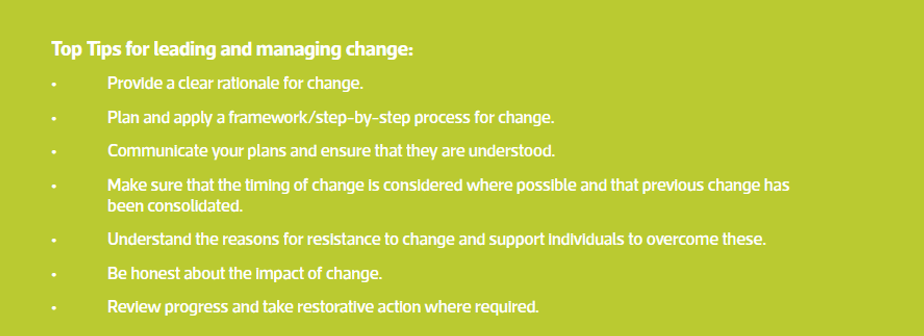Communication comes in both word and deed. Nothing undermines change more than behavior by important individuals that is inconsistent with the verbal communication. (Kotter, 2012)
What is change?
Kotter (2012) describes ‘change’ as a process of altering the way in which things are done. Change is necessary to allow organisations to continue to improve and to develop their procedures and systems, and to respond to other influences. All organisations need to respond to both internal drivers (such as over-reliance on existing methods) and external drivers (such as a change to legislation) in order to achieve goals and support continuous improvement.
The success of your organisation will rely on the ability of the leadership team and employees to respond effectively to the need for change as a result of internal or external influences and factors.
Evaluating the need for change
The first step to leading change effectively is to clearly evaluate the need for change. You can do this by examining the internal and external drivers for change. The external factors are usually reviewed as part of an ‘environment scan’ described in the terms of PESTLE: Political, Economic, Social, Technology, Legal and Environmental factors. (Change Management Institute, 2013)
That is:
Political: What political factors are likely to affect the organisation?
Economic: What economic factors are likely to affect the organisation?
Sociological: What sociological and cultural aspects are likely to affect the organisation?
Technological: What technological changes are likely to affect the organisation?
Legal: What current and impending legislation is likely to affect the organisation?
Environmental: What environmental considerations are likely to affect the organisation?

Once you have identified the need for change and identified a potential solution, there are a number of tools you can use to test the viability of your ideas. Kurt Lewin’s Force Field Analysis is a credible tool that is used to analyse the forces both for and against change. (Mindtools, 2017)
Force Field Analysis To carry out a Force Field Analysis, follow the 5 steps below:
- Describe your plan for change
- Identify the Forces for change
- Identify the Forces against change
- Rate each of the Forces
- Analyse and draw up your action plan
Lewin further developed this concept to incorporate a three-step model that considers the process of change as ‘unfreezing’, ‘changing’ and ‘refreezing’. (See ‘Change Management Models’, below)
Change Management Models
There are numerous theories of managing change. Many of these view the change process as comprising of a series of steps that those leading change need to follow.
Kurt Lewin’s three-step model views the process of change as ‘unfreezing’, ‘changing’ and ‘refreezing’. This analogy can be related to water: a block of ice first needs to unfreeze before it can change shape, and then needs to refreeze to maintain this new shape.

However, in the current environment of constant change, ‘re-freezing’ needs to be a more flexible state to ensure organisations can respond swiftly to internal and external influences. (Kotter International, 2014)
An extension of this idea is John Kotter’s eight step model of change:

Leading Change
‘Kouzes and Posner (2017) further suggest that those leading and managing change need:

Communication and ensuring that staff members understand the need for change, and are supported to embrace this, are arguably the most important skills you need to possess as a leader of change.
Nevertheless, however well you plan for change, it is likely that you will encounter some resistance or challenge. The reasons why people may resist change include:
- Fear of the unknown/loss of control, e.g. fears that job roles may be adversely affected or at risk
- Inability to cope (perceived or real), employees may feel incapable of carrying out new tasks/approaches
- Poor communication from change leaders, lack of support and understanding for those struggling
- Previous negative experiences of change

Grow your team's skills, elevate your brand reputation and more, with our corporate solution.
References
Change Management Institute (2013). The Effective Change Manager: The change management body of knowledge. 1st Ed. Brisbane: Kuhn Corp. Press.
Kotter International (2014). 8-Step Process. https://www.kotterinternational.com/8-steps-process-for-leading-change/
Kotter, J. P (2012). Leading Change. USA: Harvard Business Review Press
Mindtools (2017). Lewin’s Change Management Model: Understanding the Three Stages of Change. https://www.mindtools.com/pages/article/newPPM_94.htm
Reflect & Learn (n.d.). A Causal Model of Organizational Performance & Change (Burke & Litwin Model) http://www.reflectlearn.org/discover/a-causal-model-of-organizational-performance-change-burke-litwin-model
Strebel, P. (1996). Why Do Employees Resist Change? The Harvard Business Review. https://hbr.org/1996/05/why-do-employees-resist-change
The Leadership Challenge (n.d.). The Five Practices of Exemplary Leadership Model. http://www.leadershipchallenge.com/about-section-our-approach.aspx
Wu, T. (2010). Strategic choice – Johnson and Scholes’ Suitable, Achievable, Acceptable Model. The Learning Centre. https://www.tolobranca.nl/wp-content/uploads/2015/08/SFA-Matrix-learning_strategic_choice.pdf
How do you lead change? Test yourself with our Scorecard.
If you’re a member, you can test yourself on Leading Change and see if you meet the standard.
Spotlights
Further Resources
From the Blog








